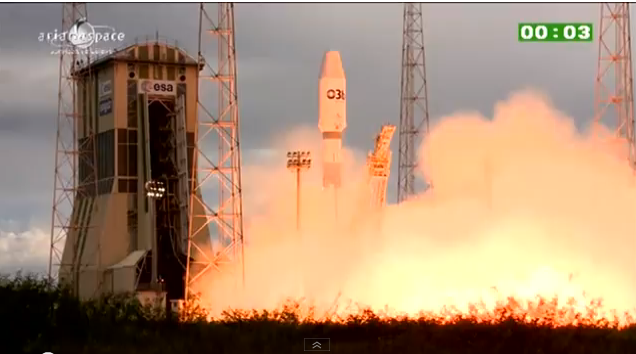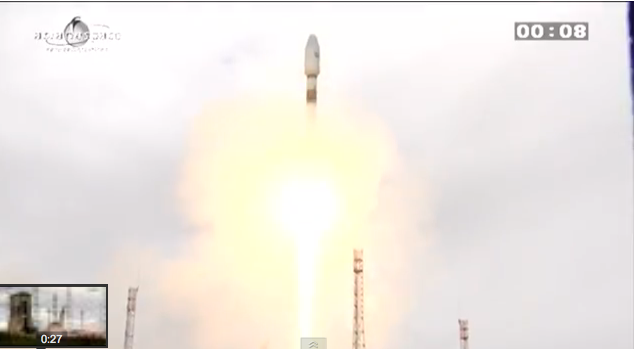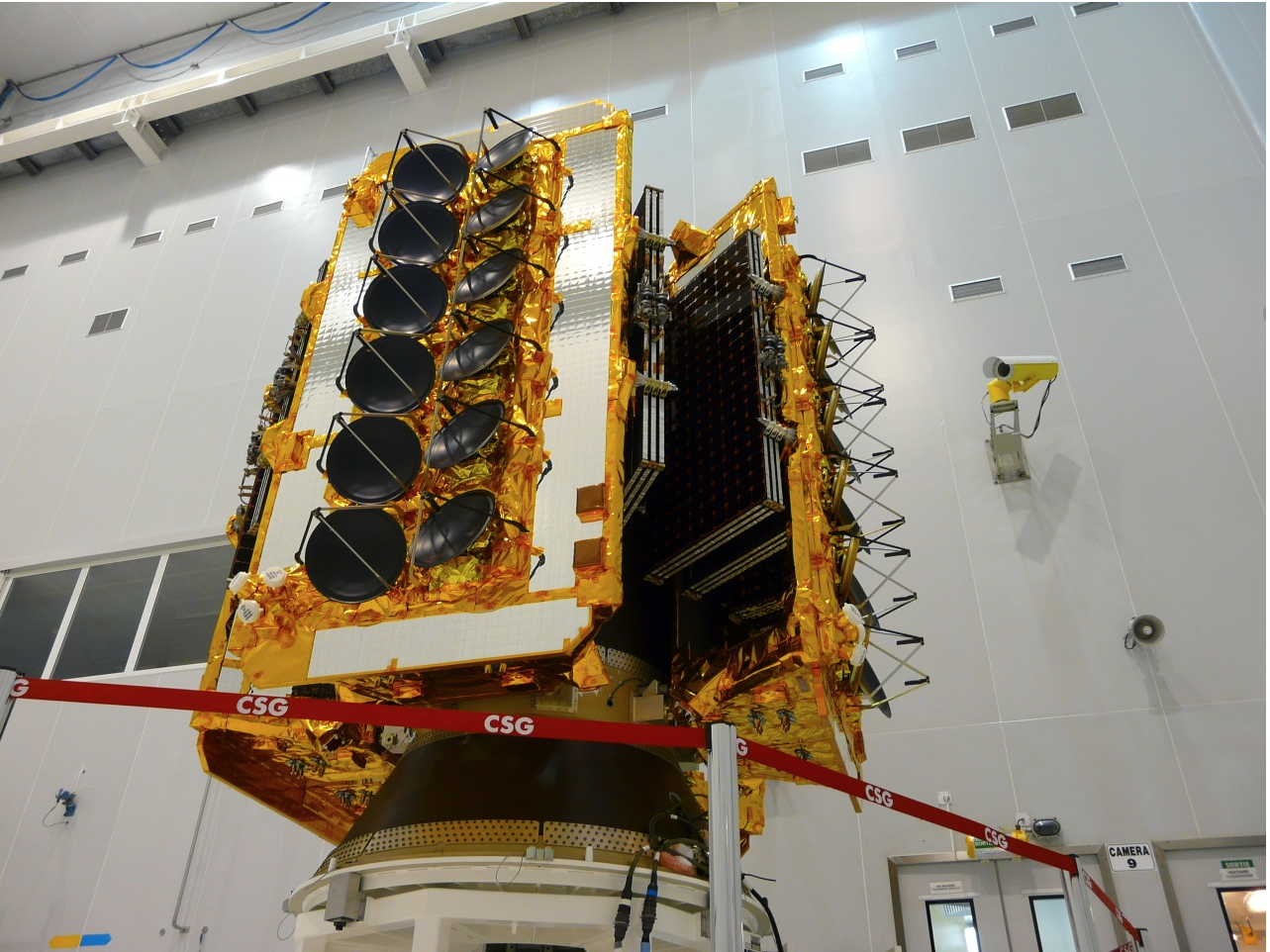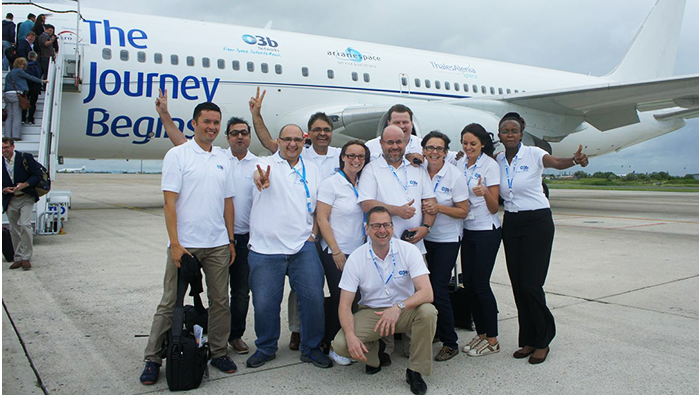
An Arianespace Soyuz ST-B rocket successfully launched four O3B satellites from the Kourou Spaceport in French Guiana on Tuesday. The launch, the second Soyuz to lift-off in close succession, was scheduled for 18:54 UTC. However, due to a red hold, the teams opted for a launch 33 minutes later. The mission is using a Soyuz-STB/Fregat-MT, a Soyuz-2-1b optimized for commercial launches from the Centre Spatial Guyanais in French Guiana, with a Fregat upper stage.
Arianespace played an important role in improving the world’s connectivity with a successful medium-lift Soyuz launch this afternoon that orbited O3b Networks’ initial four satellites.
The cluster of spacecraft lifted off on Arianespace’s maiden Soyuz mission for O3b Networks, creating the way for the establishment of telecommunications and Internet services over Asia, Africa, South America, Australia and the Middle East that combine the global reach of satellite coverage with the speed of a fiber-optic network.

Cannes, June 25, 2013 – The first four satellites in the O3b medium Earth orbit constellation were successfully launched today by Arianespace for operator O3b Networks, using a Soyuz rocket from the Guiana Space Center in French Guiana. The second batch of four satellites will also be launched this year, and the third batch in the first half of 2014.
Positioned at an altitude of 8,062 kilometers along the Equator, about four times closer to the Earth than geostationary satellites, these Ka-band satellites will provide telecommunications services and Internet connectivity combining high speed, low cost and reduced latency for emerging markets in Asia, Africa and the Middle East. O3b Networks will provide telecom operators with trunking capacity and connectivity for mobile networks, at broadband speeds comparable to those offered by fiber-optic networks.

"We are very pleased with the success of this first launch, alongside O3b Networks and Arianespace," said Nathalie Smirnov, Director of Telecommunications at Thales Alenia Space. "It marks a major step forward in the development of O3b Networks, and is also a very concrete initiative to reduce the digital divide. Everybody at our company is obviously fully mobilized to prepare for the two remaining launches."
O3b satellites are located in a so-called "repeating" Equatorial orbit, enabling a given ground station to see the same satellite every six hours – which considerably simplifies satellite architecture. Weighing 700 kg at launch, each O3b satellite is based on a platform offering 1.5 kW of power. The payload comprises 12 mobile antennas and 10 Ka-band transponders.
Thales Alenia Space has received orders for a total of 117 satellites in constellations (12 O3b, 81 Iridium NEXT and 24 Globalstar Second Generation), making it the world's leading producer for telecom constellations in medium and low Earth orbit.
Drawing on this expertise, unrivaled worldwide, Thales Alenia Space is now marketing the new EliteBus platform, already validated in orbit. EliteBus is designed for enhanced cost competitiveness, based on efficient volume production and supply chain management. In addition to telecommunications applications, EliteBus can meet requirements for Earth observation, navigation and other civil and defense missions.
O3b Networks’ strategy is to provide billions of consumers and businesses in nearly 180 countries with low-cost, high-speed, low latency Internet and mobile connectivity.
The payload is the first four communications satellites for O3b. These will be the first satellites of Jersey, a small island in the English Channel which is a British Crown Dependency, but is not part of the United Kingdom.
O3B SatsO3b’s Ka-band satellites were built by the contractor Thales Alenia Space, and are to be positioned at a medium-orbit altitude of approximately 8,060 kilometers, offering high speed, low cost, low-latency Internet and telecommunications services to emerging markets.
The spacecraft have a trapezoidal-shaped main body, which helped facilitate their integration on the payload system, which is a tube-shaped dispenser system, with the satellites mated to the upper and lower attach points.
Designated VS05 in Arianespace’s launcher family numbering system this mission involves a flight duration of 2 hours and 22 minutes.
Soyuz mated the the upper stageAfter the powered phases for the Soyuz ST-B vehicle’s first three stages, the Fregat-MT upper stage performed four burns, allowing deployment of the O3b spacecraft.
The O3b Networks’ slogan for this crucial launch was: “The Journey Begins,” with these words even emblazoned on a charter aircraft that brought its executives, as well as personnel from Arianespace, satellite manufacturer Thales Alenia Space and other guests, to French Guiana from Paris.

O3b Networks team members show the company spirit in front of a chartered Boeing 767 that brought executives and guests from Paris to French Guiana for today’s VS05 Soyuz mission. This aircraft carried the company’s slogan for today’s mission: “The Journey Begins,” along with the logos of O3b Networks, Arianespace and Thales Alenia Space.
“Definitely, we can now say that ‘the O3b journey has begun,’” said Arianespace Chairman & CEO Stéphane Israël in comments from the mission control center after confirmation of the Soyuz mission success. “Let me tell you that there is no better reward for Arianespace than seeing the happy faces of our customer in the front row. In this very moment, pride and gratitude are the two words coming naturally to my mind.”
Israël noted that O3b Networks is the 33rd new entrant in the satellite telecommunications business to choose Arianespace for launches that have started their operations.
Today’s 2 hour, 22 minute flight began with the propulsion of Soyuz’ basic three-stage launch vehicle, and was followed by four burns of its Fregat upper stage. O3b Networks’ four satellites were released in two phases from a dispenser system atop the Fregat stage for operation in medium Earth orbit.
A total of 12 O3b Networks satellites are to be orbited by Arianespace in groups of four, with the next mission planned for later this year, and another in 2014. Thales Alenia Space produced the Ka-band relay platforms, which have a liftoff mass of approximately 700 kg. each.
Total payload lift performance for this mission, designated Flight VS05 in Arianespace’s family numbering system, notating the fifth launch of its medium-lift workhorse from French Guiana, was 3,204 kg.
Today’s flight was the third since Stéphane Israël became Arianespace’s new Chairman & CEO, which he noted in post-launch comments, acknowledging that the company’s worldwide reputation is more than deserved.
“Arianespace’s key success factors are the commitment of its institutional and industrial partners, the complementarity, reliability and availability of its launch vehicle family, as well as the dedication and competency of its teams,” Israël explained. “Indeed, I wanted tonight to pay a tribute to the women and men who make Arianespace what it is on a daily basis, wherever they are located, in Evry, Kourou, or in our commercial offices abroad.
The next Arianespace mission is scheduled for July 25, using a heavy-lift Ariane 5 to orbit the Alphasat and INSAT-3D satellites.
Despite both the Soyuz for this mission and the Soyuz carrying Resurs-R launching around two hours apart – a coincidence caused by a 24 hour scrub due to weather constraints for the O3B mission—Tuesday’s launches did not set a record for the shortest gap between two launches of the same family of rocket.
That record is was broken on 18 August 1960 when the US Air Force conducted two Thor launches less than two minutes apart involving a Thor DM-18 Agena-A lifting off from Vandenberg Air Force Base, followed by a Thor DM-21 AbleStar from Cape Canaveral, which failed to orbit.
The next Soyuz launch after the O3b mission is expected to occur on 27 July, with a Soyuz-U orbiting Progress M-20M, a cargo spacecraft bound for the International Space Station.
Before that, Russia’s next launch is currently scheduled for Thursday, with the Strela rocket making its much-delayed second launch carrying a Kondor radar imaging satellite.

